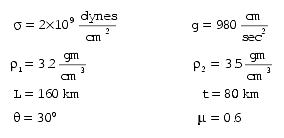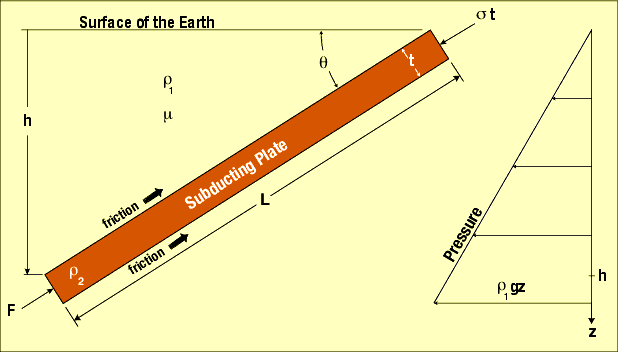Does Subduction Really Occur?
A plate, which may or may not be subducting, has a length L, thickness t, density r2, and a unit depth. It is inclined at an angle q below the horizontal and is pushed by a compressive stress s through rock whose density is r 1. Solid-to-solid friction, with a coefficient of m, acts to a depth h on both the top and bottom of the plate. The lithostatic pressure at a depth z is the mean density r1 times z times the acceleration due to gravity g. A drag force F opposes movement at the leading—and very blunt—edge of the plate.
To make subduction as likely as possible, we must assume that:
- The thrusting force, s t, is perfectly aligned with the subduction angle q.
- The thrusting force is the maximum possible, but does not exceed the crushing strength of the subducting plate.
- The plate is denser than the mantle surrounding it. (Without this assumption, the plate would not sink. Actually, the mantle, through which the plate must push, is much denser than the plate.)
For the plate to subduct, the sum of the forces down and to the left must exceed the sum of the forces up and to the right. That is:
{Net Thrust} + {Body Forces} >
{Friction on Top and Bottom Surfaces}

In dimensionless form, this simplifies to

The coefficient of static friction for rock against rock is about 0.6 and is largely independent of mineralogical composition and temperature up to about 350°C. Typical values for the above inequality are shown below.

To make subduction much more likely, let’s assume that F = 0. Substituting these values in the above inequality gives the false statement that
0.04 + 0.09 > (2.000 + 1.894) 0.6
Because the inequality cannot be satisfied, a pushing force will not cause subduction. Remember, we made the very generous assumption that F=0. In other words, the blunt end of a plate 30–60-miles thick, and hundreds of miles wide, experiences no resistance as it is pushed through the Earth’s rock crust. (Even if the coefficient of friction were only 0.031, one-nineteenth of the above value and F=0, subduction could still not occur!)
Some believe that a pulling force causes subduction. They say, for example: “at a given depth, the subducting plate is colder, and therefore denser, than the mantle. The plate sinks through the mantle, like a dense rock falling through mud. As it falls, it pulls the rest of the plate.”
This proposal overlooks the weak tensile strength of rock. If the pushing force, described above, cannot cause subduction, a much weaker pulling force certainly will not. Therefore, subduction will not occur.
